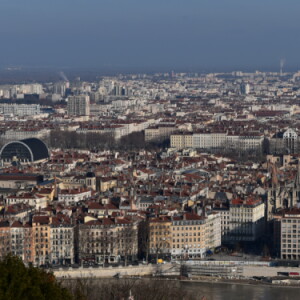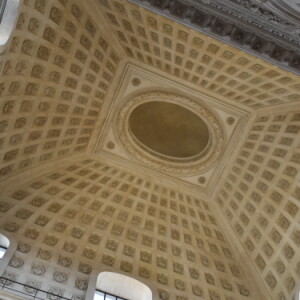Gargantua would have approved, mostly
As a general rule, believing that you are still 21 is a mistake when you are 30. When you are 50, it is stupidity. When you are either side of 60, as Tim and I are, there is little excuse to be made. Quite why we had felt the need to drink another two bottles of wine after coming out from a night in Lyon is beyond me. I can only apologise to my body and plead temporary insanity.
I was therefore somewhat chastened this morning: my head ached, my body – unused to sleep at the best of times – was reacting with horror at having been forced into the position in which it found itself at the crack of 10:30: head hanging off the edge of the fold-out sofa; one arm in the neck of the t-shirt; jeans still on; one arm snagged under the leg of bed. How I had got into this curious yoga position was beyond me, but got into it I had.
Shower, Tylenol, coffee… and then Tim suggested another walk: “if your hips can cope, that is?” To be honest, I wasn’t sure they could, but what the hell – I’m not in Lyon that often. Thankfully he agreed we could take the metro.
We wandered down to the place de l’Hôtel de Ville and then caught the funicular up to the Basilique Notre-Dame de Fourvière, which dominates the Lyon skyline in much the way Liverpool looks down on the rest of the Premier League. The basilica itself looks very impressive in its neo-gothic, neo-byzantine way – at least the outside is, I didn’t go in, instead opting for a 45-minutes wander around the outside, some of which was spent helping an old Senegalese lady understand how the funicular worked. How she managed to get up there without the funicular is beyond me (maybe she was Notre Dame de Fourvière and I shall receive the reward for my kindness in a future meeting?).
Several things struck me about this place: 1) The basilica itself is almost impossible to photograph with run-of-the-mill cameras. I looked to offer some advice to the usually ubiquitous underlings who provide help (but they had all disappeared at around the same time the Senegalese lady arrived). I was going to suggest that in an attempt to improve tourism, they might adopt the Haussman approach and just raze the surrounding residential area. This would allow for better photos and, quite frankly, better blips. But if they don’t want my advice, well, I’m not the sort to take it personally. 2) The view from the hill should be fantastic. It isn’t. I mean, it’s good, don’t get me wrong, but it isn’t breathtaking in the way Paris is from the Arc de Triomphe or Prague is from, well, everywhere. It’s all down to scale. Fourvière is simply too high. Similarly, I had good advice to offer as to how to remedy this, but nobody was around to listen. 3) The tunnels through the mountains, such a vital part of the Résistance network, are all closed. I understand why – there were lots of homeless people living there and it had become something of a “no-go area”; however, there is something incredibly frustrating about knowing a whole troglodytic site exists nearby and not being able to visit it. The same was true about Liverpool. For years, the Williamson tunnel network was the stuff of urban lore, but now…
I’d wondered why Tim had made such an effort to get us out of the house at a certain time – and now, as we stepped on to the downward funicular, two of only a dozen people, it all started to become clear. “You’ll get a bit of a shock when we get down there,” he said. “They’re creatures of habit, the Lyonnais. “On Saturday, at 3 o’clock, they come here. On Sunday, at two o’clock, they go for a three-hour stroll somewhere else. If you know that, you can live happily in Lyon.” I’d thought at the time that he was spouting his usual high level of crap, a subject in which he holds one of his PhDs – but as we stepped off the funicular and moved past the hundreds of people waiting to go up, I had to admit he was right. I say “hundreds” – it might have been more. All standing in line, waiting for the funicular to carry them up to Fourvière, 52 at a time. As we wandered to the metro, they were still coming in their waves.
We, on the other hand, had another destination in mind: the Grand Hôtel-Dieu. A quick look at Wikipedia tells you something of the historical significance of the place.
“First erected in medieval times, the building originally served as the “Confrérie des frères pontifes” (est. 1184), a pontifical meeting-place and refuge for both traveling and local members of the clergy. However, when the first doctor Maître Martin Conras was hired in 1454, ‘Hôtel-Dieu’ became a fully functional hospital, one of the most important in France. As Lyon was a city known for its trade and seasonal fairs, many of the early patients were weary travelers of foreign descent.
In 1532, '’Hôtel-Dieu’ appointed former Franciscan/Benedictine monk-turned-doctor and great Humanist François Rabelais, who would write his Gargantua and Pantagruel during his tenure here. Renaissance poet Louise Labé lived just beyond the western limits of the building.
The Hôtel-Dieu also had as a practitioner in the 1530s and 1540s, Pierre Tolet who was one of the promoters of the French language in medicine.
Massive expansion projects in the 17th century by Guillaume Ducellet (under Louis XIII and Cardinal Richelieu) and in the 18th century by Jacques-Germain Soufflot (under Louis XIV and Jean-Baptiste Colbert) replaced the original building with the grandiose wings and courts we know today. In fact, at its greatest point, the hospital extended from its present position beyond Place Bellecour to engulf the area now occupied by the central post office.
‘Hôtel-Dieu’ houses the “Musée des Hospices Civils” a permanent exhibit tracing the history and practice of medicine from the Middle Ages to modern time and includes a fine collection of apothecary vases amongst other objects.”
Now, as fascinated as I am by fine collections of apothecary vases – and, removing tongue from cheek, as I actually am by Rabelais (Gargantua was one of the books we had to study at university, and one of the few I read in my first-year course) – we were headed somewhere else. We were going to “Le Dôme” bar.
I’ll start with this: if you fancy sitting in exquisite surroundings and eating cakes surrounded by the “hoi oligoi” – then come here. If you fancy being overwhelmed by the 32-metre high ceilings of the former hospital, while tautly buttocked waitresses (and waiters) cater for your gustatory needs, come here. And if, like me, you want a restorative glass of arguably the world’s best calvados (the Christian Drouin XO), then FOR GOD’S SAKE COME HERE. The downside is, of course, price. At 27€ per glass, you have three options: 1) run (not for me, couldn’t get the hips working fast enough; 2) feign illness and see if the hospital is still in someway functional; 3) make sure you arrive second to the till, and let your friend pay. I’ll let you guess which of those I did. It’s worth going though. And, in case you were wondering, Gargantua would approve of the gourmandise, if not the quantities.
Home via a supermarket, then watched some rugby on tv, and finally got to say hello to Salima, Tim’s significantly better half. Dinner of Argentinian empanadas.




Comments
Sign in or get an account to comment.


